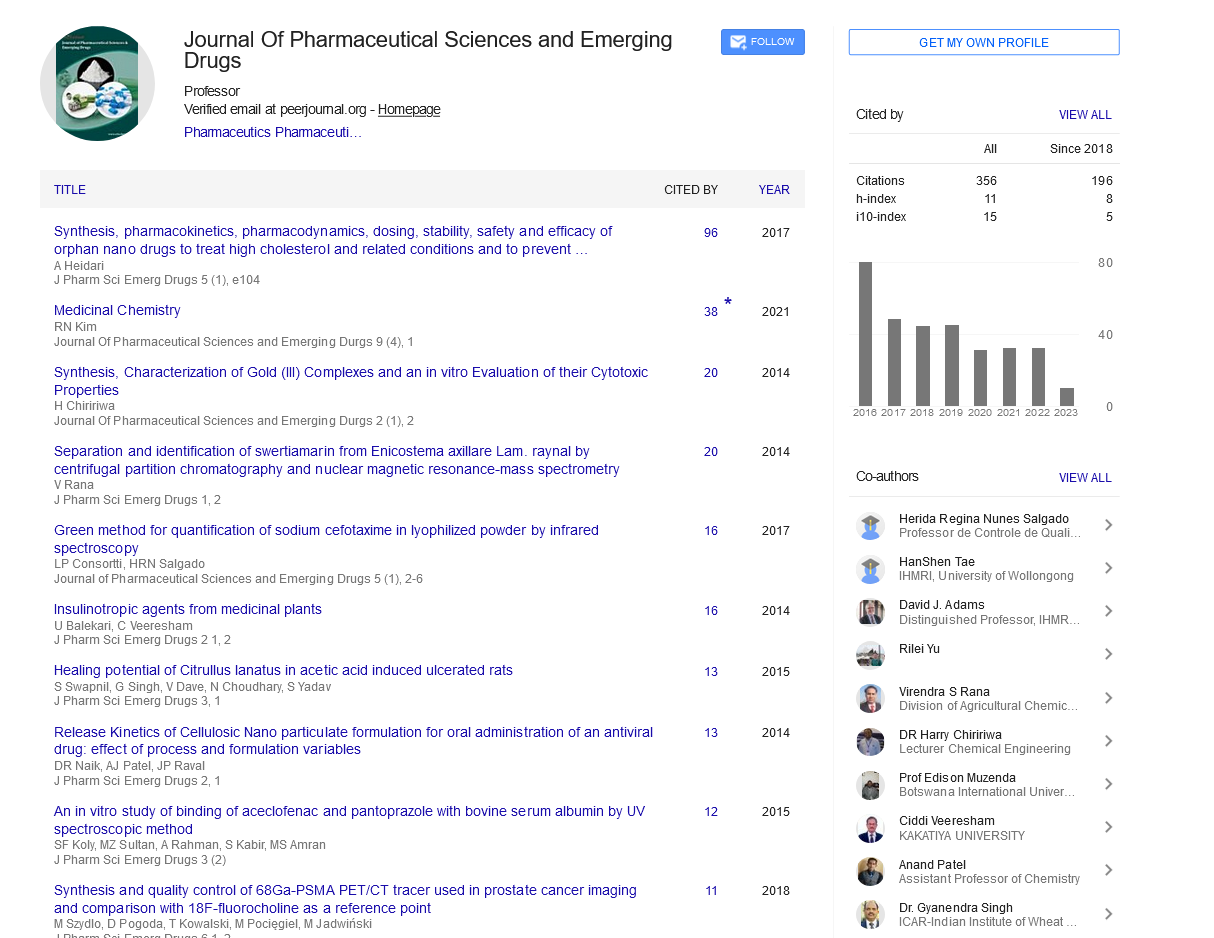Short Communication, J Pharm Sci Emerg Drugs Vol: 12 Issue: 4
Bio-organic Chemistry Approaches to Modulating Protein- Ligand Interactions
Stephen Dalke*
1Department of Biochemistry, University of Illinois, Chicago, United States of America
*Corresponding Author: Stephen Dalke,
Department of Biochemistry, University
of Illinois, Chicago, United States of America
E-mail: sdalke@gmail.com
Received date: 21 July, 2024, Manuscript No. JPSED-24-148157;
Editor assigned date: 23 July, 2024, PreQC No. JPSED -24-148157 (PQ);
Reviewed date: 06 August, 2024, QC No. JPSED -24-148157;
Revised date: 13 August, 2024, Manuscript No. JPSED-24-148157 (R);
Published date: 20 August, 2024, DOI: 10.4172/2380-9477.1000202.
Citation: Dalke S (2024) Bioorganic Chemistry Approaches to Modulating Protein-Ligand Interactions. J Pharm Sci Emerg Drugs 12:4.
Abstract
Description
Enzymes are utilized in almost every industrial area, including food, pharmaceuticals, textiles, biofuels, paper, chemicals and household goods. Their range of applications is incredibly wide. Biocatalysts, also known as enzyme-mediated or enzymatic catalysis, have become a vital tool in the production of fine chemicals, medicines and related intermediates[1]. For a variety of the biotransformation’s, including oxidations, reductions, additions and eliminations, enzymes are available. All biological processes in living things are based on molecular recognition, which is the process by which different tiny molecules with high specificity and affinity engage with one another to produce a particular complex[2]. One significant type of biological macromolecules that binds to other molecules or itself to carry out its function is the protein.
Thus, a thorough comprehension of protein-ligand interactions is essential to comprehending biology at the molecular level. Furthermore, understanding the processes behind protein-ligand recognition and binding can help with drug discovery, design and development. First, the physicochemical mechanisms governing protein–ligand interaction are presented and explained in this study. These mechanisms include binding kinetics, thermodynamic ideas and connections and binding driving forces. Subsequently, three extant protein-ligand[3] . Recently, Novartis and Codex is developed the amine transaminase enzyme CDX-043 to asymmetrically introduce an amine into the large molecular structure of sacubitril, the chiral precursor and main ingredient in the popular cardiovascular medication Entresto[4].
The chemical synthetic method to sacubitril involves a complex multistep synthesis requiring environmentally harmful chemicals, protecting groups and the production of considerable amounts of organic waste, although offering high yields and enantiomeric and diastereomeric purity. An enzyme that could accept the sacubitril precursor and function under industrially relevant conditions needed to be extensively engineered in order to provide an efficient and economical bio catalytic transamination method. The initial enzyme, which had trace activity and a propensity for the undesirable diastereomer, was evolved into the variation, after 11 rounds[5]. In research released in 2017, Pfizer decided to use two enzymes that were selected using bioinformatics to create two important chiral intermediates for their innovative anticancer gamma secretase drug candidate chemo enzymatic synthesis.
Initially, a fluorine-substituted tetra lone was reductively aminate to the corresponding (S)-amine in a 95% yield and >99% e.e. using a transaminase (ATA-47 from Celta). A multi kilogram-scale reduction of an α-ketoester catalyzed by alcohol dehydrogenase produced the second target intermediate, (R)-α-hydroxyester, with an 88% yield and 96.7% e.e. The alcohol and amine compounds produced by enzymatic synthesis might then be combined to provide a major intermediate in the gamma secretase inhibitor[6]. This work demonstrates the growing acceptance of biocatalysts as a practical technology. Protein-ligand interactions are a necessary prerequisite for signal transduction, immunoreaction and gene regulation. Studies of protein-ligand interactions are important for comprehending the biological regulating mechanisms and for providing a theoretical framework for the development and identification of novel therapeutic targets[7].
References
- O’Connell A, Barry A, Burke AJ, Hutton AE, Bell EL, et al. ( 2024) Biocatalysis: landmark discoveries and applications in chemical synthesis. Chem Soc Rev.
[Crossref] [Google Scholar] [Pubmed]
- Halperin I, Ma B, Wolfson H, Nussinov R. (2002) Principles of docking: An overview of search algorithms and a guide to scoring functions. Proteins 47(4):409-443.
[Crossref] [Google Scholar] [Pubmed]
- Chen R, Li L, Weng Z. (2003) ZDOCK: an initial‐stage protein‐docking algorithm. Protein 52(1):80-87.
[Crossref] [Google Scholar] [Pubmed]
- Veber DF, Johnson SR, Cheng HY, Smith BR, Ward KW, et al. (2002) Molecular properties that influence the oral bioavailability of drug candidates. J Med Chem 45(12):2615-2623.
[Crossref] [Google Scholar] [Pubmed]
- Phillips JC, Braun R, Wang W, Gumbart J, Schulten K, et al. (2005) Scalable molecular dynamics with NAMD. J Comput Chem. 26(16):1781-1802.
[Crossref] [Google Scholar] [Pubmed]
- MacRaild CA, Daranas AH, Bronowska A, Homans SW. (2007) Global changes in local protein dynamics reduce the entropic cost of carbohydrate binding in the arabinose-binding protein. J Mol Biol 368(3):822-832.
- Amzel LM. (2000) Calculation of entropy changes in biological processes: folding, binding, and oligomerization. In Methods in enzymology Vol. 323:167-177.
[Crossref] [Google Scholar] [Pubmed]
 Spanish
Spanish  Chinese
Chinese  Russian
Russian  German
German  French
French  Japanese
Japanese  Portuguese
Portuguese  Hindi
Hindi 